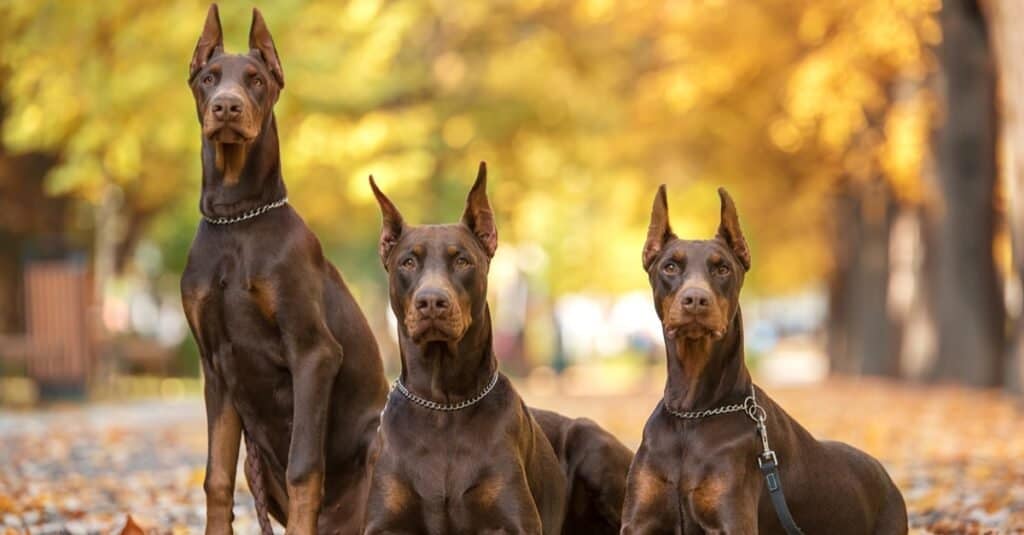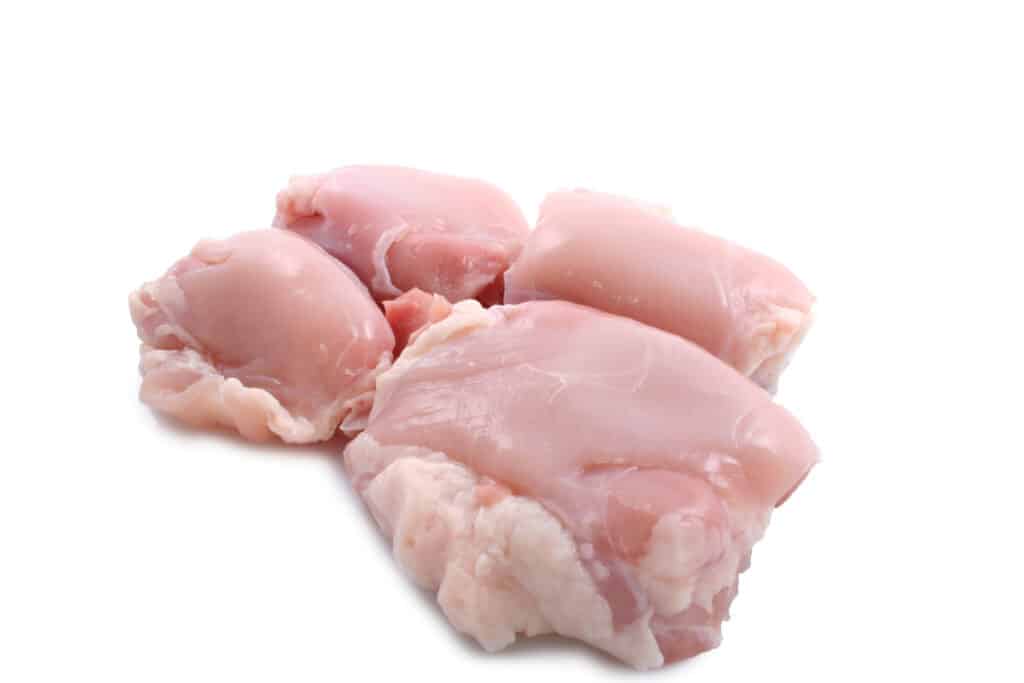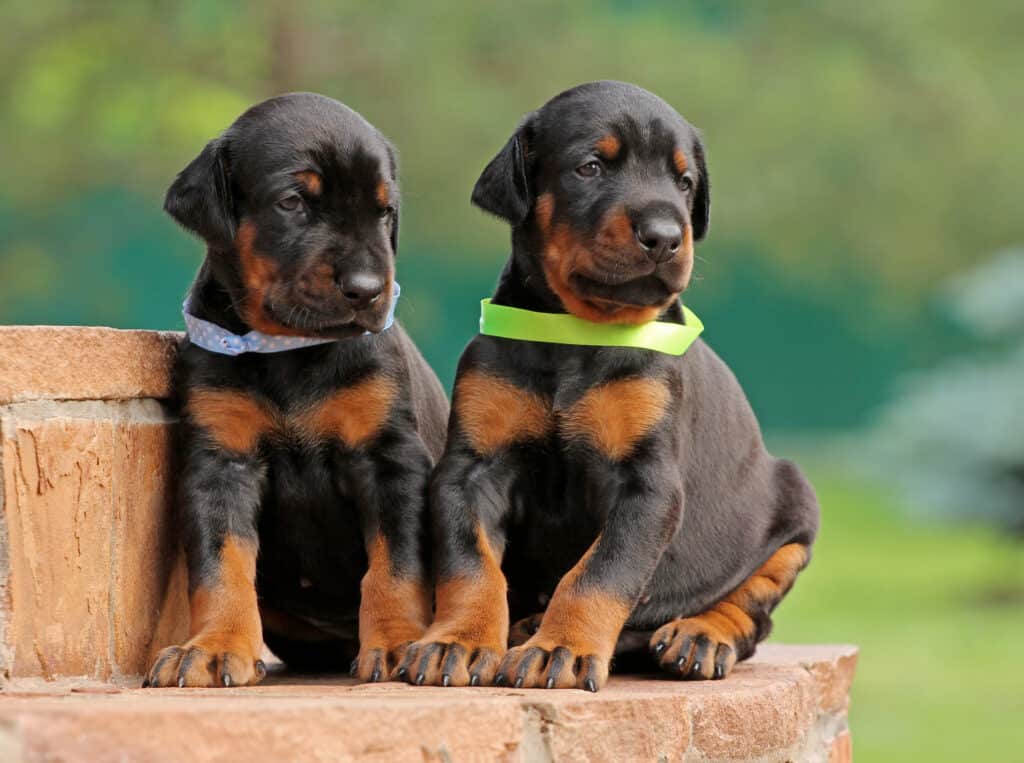Introduction

Dobermans may have a reputation for being frightening, but to their owners, these dogs are incredibly loving.
©SasaStock/Shutterstock.com
The Doberman Pinscher, one of the strongest breeds, is known for its excellent working ethic. The dog is agile and powerful, so it is often trained to provide protection. However, many pet owners prefer Dobermans because they are kind, affectionate, sweet, and can freely socialize with people.
Louis Doberman, a tax collector, first developed this dog in the 19th century. Tax collecting was a dangerous job, and Louis had to get a guard to help him perform his duties. Since then, people started rearing Dobermans as guardians, military and police dogs, and service canines. However, if you are getting a Doberman as a pet and not as a service dog, you must still train it at a young age.
The Different Types of Doberman
The two main types of Doberman are the American and European. These two types have varying characteristics that are easy to differentiate. For example, the American Doberman is sleek, elegant, and often used as a family dog. The European Doberman is larger and more muscular and is often high-strung and not suited for families.
The Doberman at a Glance
| Preferred temperature | Warm climate |
| Shedability | Moderate |
| General Health | Generally healthy dogs |
| Size | Medium to large |
| Energy level | High energy |
| Exercise needs | High 60+ minutes daily |
| Friendly with other dogs | Moderate — Average relations with other dogs |
| Family and kid-friendliness | Affectionate and good with children |
| Trainability and obedience | High ability to learn and train |
| Temperament | Energetic and intelligent |
| Yappiness and barking | High |
| Tendency to chew | Moderate desire to chew |
| Purebred cost to own | $1,000-$3,000 |
| Dog Group | Working |
| Used for hunting | No |
| Intelligence | Very intelligent |
| Hypoallergenic (non-shedding) | No |
| Life Span | 10-12 years |
| Female Weight Minimum | 60lbs |
| Female Weight Maximum | 90lbs |
| Male Weight Minimum | 75lbs |
| Male Weight Maximum | 100lbs |
| Separation Anxiety | High — Likely to suffer from separation anxiety |
| Fun Fact | A tax collector first bred Doberman dogs |

The European Doberman is more muscular than the American variety, and with a higher drive.
©Slavko Zec/Shutterstock.com
10 Different Types of Dobermans and Doberman Mixes
Mixing Dobermans with other breeds brought forth a new dogs with different characteristics. However, although there was a new twist in the species, most Doberman mixes maintained the black color, but they could have a curly, long, and wavy coat.
The 10 different variations of Dobermans are:
- Rotterman: a cross between the Doberman Pinscher and Rottweiler.
- Englishman: a cross between the Doberman Pinscher and English Bulldog.
- Doberdane: a cross between the Doberman Pinscher and Great Dane.
- Dobie: a cross between the Border Collie and Doberman Pinscher.
- Doddleman: a cross between the Doberman Pinscher and Poodle.
- Doberman Shepherd: a cross between the Doberman Pinscher and German Shepherd.
- Beagleman: a cross between the Doberman Pinscher and Beagle.
- Doberhound: a cross between the Doberman Pinscher and Greyhound.
- Doberalian: a cross between the Doberman Pinscher and Australian Shepherd.
- Wolfman: a cross between the Doberman Pinscher and Irish Wolfhound.
The Best Dog Food for Dobermans
You want to keep your muscular and loyal Doberman healthy and energetic, and there is no better way to do that than providing it with the best food available. These dogs are athletic and active, so their diet should be nutritionally rich for all their exercise and energy.
Since Dobermans are big and energetic dogs, they need food rich in proteins and fat. It should also have omega fatty acids, which give the canine a healthy coat, skin, and strong joints. The diet should also consist of berries to provide antioxidants.
For the puppies, they need a deboned chicken as the first portion of their meals. Ensure their food has other animal proteins from different sources such as beef and pork to provide fats for proper development.
When choosing a Doberman’s food, consider foods that will increase hydration. When the dog ages, you can switch their food to senior dog food that will protect them from joint problems.

Deboned chicken is ideal for a Doberman
puppy’s diet
.
©Collinquint21/Shutterstock.com
Owning a Doberman: 3 Pros and Cons
| Pros | Cons |
|---|---|
| A very loyal canine friend | Separation Anxiety |
| Dobermans listen to their owners, are determined, alert, and very protective. This dog has a well-conditioned appearance, which they use to warn intruders. | You might have difficulty leaving your Doberman at home alone because they might excessively bark or howl. These are symptoms of anxiety, and they can be upsetting to the dog owner. |
| Beauty and brains | Health Problems |
| The breeds have different coat hues, including black, blue, and red. They are also famous for their intelligence and can quickly learn and practice new commands. | Dobermans are more prone to life-threatening diseases like digestive conditions, such as bloating which can be serious. They also easily get hip dysplasia, so their owners should get dog insurance for easy treatment. |
| Cheap to maintain | Same-Sex Aggression |
| A Doberman will cost you very little money to maintain its coat. Use a short-bristled brush to brush them daily. | If you walk your Doberman and they meet other dogs of the same sex, they can be aggressive toward them because they want to be dominant. |
Doberman Size and Weight
The Doberman males grow to 28 inches tall, weighing about 75 to 100 pounds. Females are shorter and grow to a height of 26 inches. Adult female Dobermans weigh 60 to 90 pounds.
| Height (male) | 28′ tall |
| Height (Female) | 26′ tall |
| Weight (male) | 75-100 pounds |
| Weight (female) | 60-90 pounds |
Doberman Common Health Issues
Although Dobermans are strong, they are prone to canine hip dysplasia (CHD). The disease causes the head of the femur bone and the hip socket to meet incorrectly. Symptoms of this condition are stiff back legs and lameness (the dog can barely use its limbs for walking or playing).
Another health issue for Dobermans is cardiomyopathy, which affects the heart. It can sometimes be diagnosed at late stages, which might be fatal. Dog owners should also watch out for demodicosis in this breed. It is caused by too many mites on the dog’s skin.
Make sure to monitor your pet for gastric torsion. The symptoms are hard to notice, and you could discover the condition when it’s too late. This condition is caused by a stomach twist at the top and bottom, which blocks gas from exiting the stomach.
Doberman Temperament and Behavior
Dobermans are affectionate, sweet, and loyal dogs to their owners. They are also powerful, intelligent, and energetic, making them formidable guard dogs. If you want your Doberman to be a good family pet – you must socialize it when it is a puppy.
Doberman owners must also introduce their pets to careful socializing and obedience training when young. These dogs respond well to positive reinforcements and are easy to teach. If you want your Doberman’s natural protection traits to come out, train them to hold their aggressive nature in check until it is needed in threatening situations.
Their trustworthy and protective behavior make them good with children in their families. These canines are also playful, so they will keep your child entertained, so long as they are treated with the usual respect and boundaries a dog deserves.
How to Take Care of a Doberman:
Doberman Maintenance and Grooming
A Doberman is extremely easy to care for in the grooming department. Keep his ears clean by gently wiping the insides with a soft cloth to help protect against mites and infections, and keep his nails trimmed and teeth brushed. He won’t need frequent baths and extensive brushing isn’t necessary. However, a Doberman does shed, so a quick daily brush can keep your home free of dog hair,
Doberman Training
Doberman owners should seek professional advice on training techniques for this highly intelligent, but particular breed. As one trainer put it, “You absolutely have to know how to handle them. You never ask a Doberman; you always tell him what to do. You must show him what you want.” This breed loves routine – so schedule their training session for the same time every day. If you run an hour late one day, don’t be surprised to come home to an unhappy dog.
Doberman Exercise
Dobermans require a lot of exercise, for their bodies and minds. These dogs would love to join you for long walks and jogs. They also enjoy and benefit from agility training and tracking classes. Provide your pet with toys that keep him engaged and stimulate his active, naturally curious mind.
Try scheduling walks at a specific daily time and add high-intensity games like fetch to keep both you and your dog healthy.
Doberman Puppies and Kids
It’s a good idea to get a puppy if you want to train a Doberman to be around kids. It is up to you to make sure your pup is properly socialized and trained to be around others. Teach your kids how to properly handle animals, how to behave around dogs and to not bother a dog when he is eating. Your dog should be taught how to behave around kids to ensure a safe and happy relationship between you children and pup. Your puppy should also enjoy frequent encounters with non-immediate family members so he can get used to being around people. He will naturally bond with and protect his family – so be sure to socialize your puppy early so you can invite friends over safely.

Dobermans need to be socialized from when they’re puppies or they won’t trust anyone else but their owners.
©Pavel Shlykov/Shutterstock.com
Dogs Similar to Doberman
Other dog breeds similar to Doberman are:
- Transylvanian Hound: has similar features to the Doberman, like size, coat color, and personality. This dog is also mainly used for guarding.
- Weimaraner: like the Doberman, Weimaraners are also affectionate and create a bond with adults and children. This dog is also intelligent and gets highly anxious after separation.
- Rottweiler: Rottweilers are intelligent and quickly take instructions. They also have a guarding instinct, making them protective of the owner.
The photo featured at the top of this post is © JELIZAVETA KARAKAJA/Shutterstock.com
Ready to discover the top 10 cutest dog breeds in the entire world?
How about the fastest dogs, the largest dogs and those that are -- quite frankly -- just the kindest dogs on the planet? Each day, AZ Animals sends out lists just like this to our thousands of email subscribers. And the best part? It's FREE. Join today by entering your email below.
Sources
- American Kennel Club, Available here: https://www.akc.org/expert-advice/dog-breeds/doberman-pinscher-history-surprising-past-behind-breed/
- Doberman Pinscher Club of America, Available here: https://dpca.org/breed/breed-history/
- Purina, Available here: https://www.purina.com.au/dogs/breeds/dobermann-pinscher#.YqnBFXZBzIU
- American Kennel Club, Available here: https://www.akc.org/dog-breeds/doberman-pinscher/
- American Kennel Club, Available here: https://www.akc.org/expert-advice/health/hip-dysplasia-in-dogs/
FAQs (Frequently Asked Questions)
How much does a Doberman cost to own?
Doberman puppies cost about $1000 and $2500. The European breed is more expensive, and it costs over $3000. However, there are plenty of Dobermans that need adopting, so this is really the best choice.
Are Dobermans good with kids?
Dobermans are affectionate dogs and are loyal to their family. They can be very friendly and playful with kids they were raised with.
How long do Dobermans live?
The average life span of a Doberman is 10 to 12 years. The owners must take good care of the dog and schedule regular checkups.
Thank you for reading! Have some feedback for us? Contact the AZ Animals editorial team.






